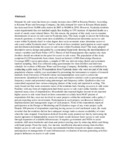| dc.description.abstract | Demand for safe water has been on a steady increase since 2005 in Kisumu District. According to Kisumu Water and Sewerage Company, the daily demand for water in Kisumu Municipality has increased from 18,000 cubic metres in 2005 to 40,000 in 2010. However, Nyalenda residents water requirements has not matched supply thus leading to 15% increase of reported deaths as a result of unsafe water related illness. For this reason, the purpose of this study was to examine determinants of access to safe water in Nyalenda slum.
The study sought to answer the following research questions; to what extent does availability of infrastructure determine access to safe water within Nyalenda slum? to what degree does socio-economic status determine access to safe water within Nyalenda slum? And to what level does residents' participation in water supply and distribution determine the access to safe water within Nyalenda slum? The study adopted descriptive survey design and guided by a conceptual framework showing the interrelatedness of various variables and Paulo Freire (1971) Theory of Self Emancipation that explain why slum dwellers should not relent on the quest for access to safe water. The population of this study comprised 8,229 households from where, based on Sarriot's (1999) Knowledge-Practices-Coverage (KPC) survey procedure, a sample of 300 was derived using cluster and systematic random sampling.
Data was collected using questionnaire for slum dwellers and interview schedule for workers of Kisumu Water and Sewerage Company. Reliability was established by conducting a pilot study on 30 respondents from Nyalenda slums who were not part of the study population whereas validity was ascertained by presenting the instruments to experts of research methods from University of Nairobi whose recommendations were used to correct the instruments. Quantitative data was analyzed using descriptive statistics such as percentages and frequency counts and presented using percentages and frequency tables. Qualitative data was transcribed organized into various emerging themes of the study and reported in writing. The study found out that socio-economic status of the residents had a bearing on access to safe water.
Families with any form of employment had better access to safe water unlike families which reported many cases of dependencies. Households that reported higher income levels reported higher access to safe water based on litres consumed on a daily basis.96.67 percent of respondents felt they were not involved in water projects within the settlement with a paltry 3 percent reporting active involvement. Participation in such projects was however limited to implementation and management stages of such projects. None of the respondents reported participation at the Design or Monitoring and Evaluation stages of any water project cycle.
Despite 100 percent of respondents reporting having access to roof catchment water, the study revealed that the residents did not have adequate storage tanks to ensure availability of water when the rains stopped. Conclusions derived from this study pointed out that by motivating the master operators to independently source for funds would increase faster access to safe water through expansion of available infrastructure. It requires government and NGOs to assist residents drill more boreholes and clean and protect existing ones by removing debris and fitting with hand pumps. From the study, low income, insufficient education among slum dwellers hinders access to safe water. The study recommended further research on impact community participation on management of water infrastructure, evaluation of income generating activities projects influence on access to safe water. | en_US |

